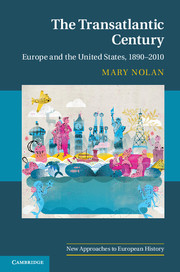Book contents
- Frontmatter
- Contents
- Illustrations
- Maps
- Tables
- Acknowledgments
- Introduction
- 1 An uncertain balance, 1890–1914
- 2 World War I: European crisis and American opportunity
- 3 Ambivalent engagement
- 4 The depression and transatlantic new deals
- 5 Strange affinities, new enemies
- 6 From world war to Cold War
- 7 Cooperation, competition, containment
- 8 Culture wars
- 9 The American Century erodes, 1968–1979
- 10 Renewed conflict and surprising collapse
- 11 A widening Atlantic
- 12 Imperial America, estranged Europe
- Suggested readings
- Index
- References
1 - An uncertain balance, 1890–1914
Published online by Cambridge University Press: 05 November 2012
- Frontmatter
- Contents
- Illustrations
- Maps
- Tables
- Acknowledgments
- Introduction
- 1 An uncertain balance, 1890–1914
- 2 World War I: European crisis and American opportunity
- 3 Ambivalent engagement
- 4 The depression and transatlantic new deals
- 5 Strange affinities, new enemies
- 6 From world war to Cold War
- 7 Cooperation, competition, containment
- 8 Culture wars
- 9 The American Century erodes, 1968–1979
- 10 Renewed conflict and surprising collapse
- 11 A widening Atlantic
- 12 Imperial America, estranged Europe
- Suggested readings
- Index
- References
Summary
In the decades before World War I transatlantic relations were paramount neither for the United States nor for states across Europe. The world was multipolar and rapidly globalizing. Britain remained the dominant economic and colonial power. While exchanges of goods, capital, ideas, and people across the Atlantic were increasing rapidly, for both Europe and the United States, the North Atlantic world was just one arena of economic and political interest and interaction, and transatlantic relations were often triangulated through imperial concerns in Asia, Latin America, and Africa. The American Century had not yet begun. But was it visible on the horizon?
Many historians view the twentieth-century rise of the United States as preordained due to America’s economic might, geography, or purported political and cultural exceptionalism. Likewise, the end of European hegemony appears predictable due to imperial overreach, nation-state rivalries, and less robust economies. In the decades before World War I, however, the new world did not dominate the old, and the United States was a nation among nations. It was unclear how the transatlantic balance of economic, political, and cultural power would evolve.
- Type
- Chapter
- Information
- The Transatlantic CenturyEurope and America, 1890–2010, pp. 10 - 51Publisher: Cambridge University PressPrint publication year: 2012

